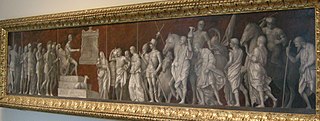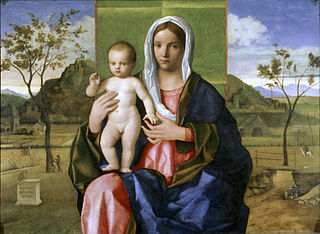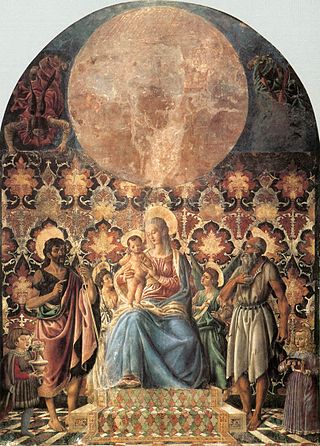
Giovanni Bellini was an Italian Renaissance painter, probably the best known of the Bellini family of Venetian painters. He was raised in the household of Jacopo Bellini, formerly thought to have been his father, but now that familial generational relationship is questioned. An older brother, Gentile Bellini was more highly regarded than Giovanni during his lifetime, but the reverse is true today. His brother-in-law was Andrea Mantegna.

Jacopo Bellini was one of the founders of the Renaissance style of painting in Venice and northern Italy. His sons Gentile and Giovanni Bellini, and his son-in-law Andrea Mantegna, were also famous painters.

Andrea del Castagno or Andrea di Bartolo di Bargilla was an Italian Renaissance painter in Florence, influenced chiefly by Masaccio and Giotto di Bondone. His works include frescoes in Sant'Apollonia in Florence and the painted equestrian monument of Niccolò da Tolentino (1456) in Florence Cathedral. He in turn influenced the Ferrarese school of Cosmè Tura, Francesco del Cossa and Ercole de' Roberti.

The Portrait of Sigismondo Pandolfo Malatesta is a painting attributed to the Italian Renaissance master Piero della Francesca. It portrays the condottiero and lord of Rimini and Fano Sigismondo Pandolfo Malatesta, and is housed in the Musée du Louvre of Paris.

The San Giobbe Altarpiece is a c. 1487 altarpiece in oils on panel by the Venetian Renaissance painter Giovanni Bellini. Inspired by a plague outbreak in 1485, this sacra conversazione painting is unique in that it was designed in situ with the surrounding architecture of the church, and was one of the largest sacra conversazione paintings at the time. Although it was originally located in the Church of San Giobbe, Venice, it is now in the Gallerie dell'Accademia in Venice after having been stolen by Napoleon Bonaparte.

The Gypsy Madonna is a panel painting of the Madonna and Child in oils of about 1510–11, by Titian, now in the Kunsthistorisches Museum in Vienna. It is a painting made for display in a home rather than a church.

Count Alessandro Contini-Bonacossi was an Italian politician, art collector, dealer and philatelist. In 1939 he was made a Senator of the Kingdom of Vittorio Emanuele III.

The Continence of Scipio or An Episode from the Life of Publius Cornelius Scipio is a painting in oils on canvas by the Italian Renaissance artist Giovanni Bellini, dating to 1507–08 and now in the National Gallery of Art in Washington, D.C.

St. Jerome in the Desert or St. Jerome Reading in the Desert is a 1480 oil-on-panel painting by the Italian Renaissance master Giovanni Bellini, now in the Uffizi Gallery in Florence as part of the Contini Bonacossi collection, giving it its alternative title of The Contini Bonacossi St. Jerome.

The 'Madonna and Child or Madonna with the Christ Child Blessing is a 1510 oil-on-panel painting by the Italian Renaissance master Giovanni Bellini, painted when he was already in his eighties but still responding to new developments in painting. It is similar to the 1505 Madonna del Prato and the 1509 Madonna and Child. It is now in the Pinacoteca di Brera in Milan.

Madonna Adoring the Sleeping Christ Child is a c.1475 tempera-on-panel painting by the Italian Renaissance artist Giovanni Bellini, measuring 77 cm by 56 cm. It forms part of the Contini Bonacossi Collection within the Uffizi Gallery in Florence.

Madonna and Child with Saint Mary Magdalene and Saint Ursula or Virgin and Child with Saints Magdalene and Ursula is an oil on panel painting by Giovanni Bellini that belongs to the sacra conversazione genre and dates to 1490. The painting is also referred to as Sacred Conversation. It was previously in the collection of the painter Carlo Maratta, and is now in the Prado Museum in Madrid.

The Madonna and Child with St. John the Baptist and a Female Saint or the Giovanelli Sacred Conversation is an oil painting on panel by the Italian Renaissance master Giovanni Bellini, dated to before 1504. It is kept in the Gallerie dell'Accademia of Venice.

The Portrait of Georg Fugger is a 1474 oil-on-panel portrait painting by the Italian Renaissance artist Giovanni Bellini, now in the Norton Simon Museum in Pasadena, United States. It is his earliest surviving portrait and one of the first works in oil by an Italian artist.

Allegory of Chastity is a c.1505 oil-on-panel painting by the Italian Renaissance artist Lorenzo Lotto.

Madonna and Child with Saint Roch and Saint Sebastian is an oil-on-canvas painting by the Italian Renaissance artist Lorenzo Lotto, created c. 1518, now in the National Gallery of Canada, in Ottawa. On the left is Saint Roch and to the right is Saint Sebastian.

Portrait of Iseppo da Porto and his son Adriano is a c.1555 oil-on-canvas painting by Paolo Veronese, now in the Contini Bonacossi collection, on long-term loan to the Uffizi in Florence. Veronese also decorated Porto's Palazzo Porto in Vicenza, designed by Andrea Palladio and completed in 1552.

Madonna and Child with Eight Saints is an oil painting on canvas of c. 1515–1520 by Bramantino, originally in the church of Santa Maria del Giardino in Milan and now in the Contini Bonacossi collection at the Uffizi in Florence. It belongs to the sacra conversazione genre.

The Casa Pazzi Madonna is a fresco fragment by Andrea del Castagno, created in 1443, originally the altarpiece of the chapel of Santa Brigida at the castello del Trebbio in the Pontassieve district, then owned by Andrea de' Pazzi, hence the painting's name. Removed from the wall in the 19th century it is now in the Contini Bonacossi collection within the Uffizi in Florence.



















